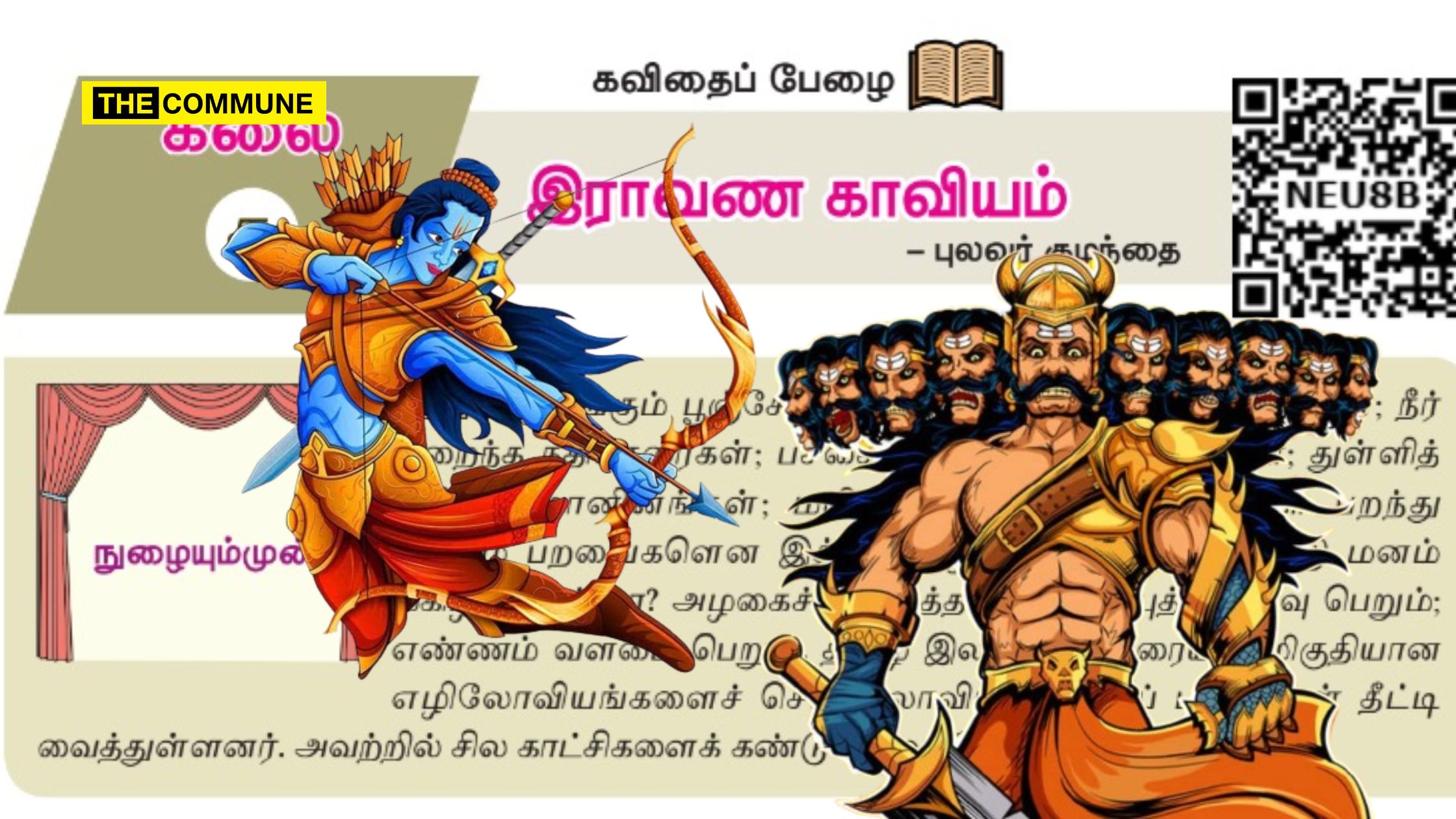
The paradox of tolerance: Unlimited tolerance must lead to the disappearance of tolerance. If we extend unlimited tolerance even to those who are intolerant if we are not prepared to defend a tolerant society against the onslaught of the intolerant, then the tolerant will be destroyed, and tolerance with them. – Karl Popper.
Poisonous Creepers In School Curriculum
When one looks into the contents of the textbooks of the schools in Tamil Nadu, one will be shocked, to say the least. Here are two examples from the ninth standard Tamil book:
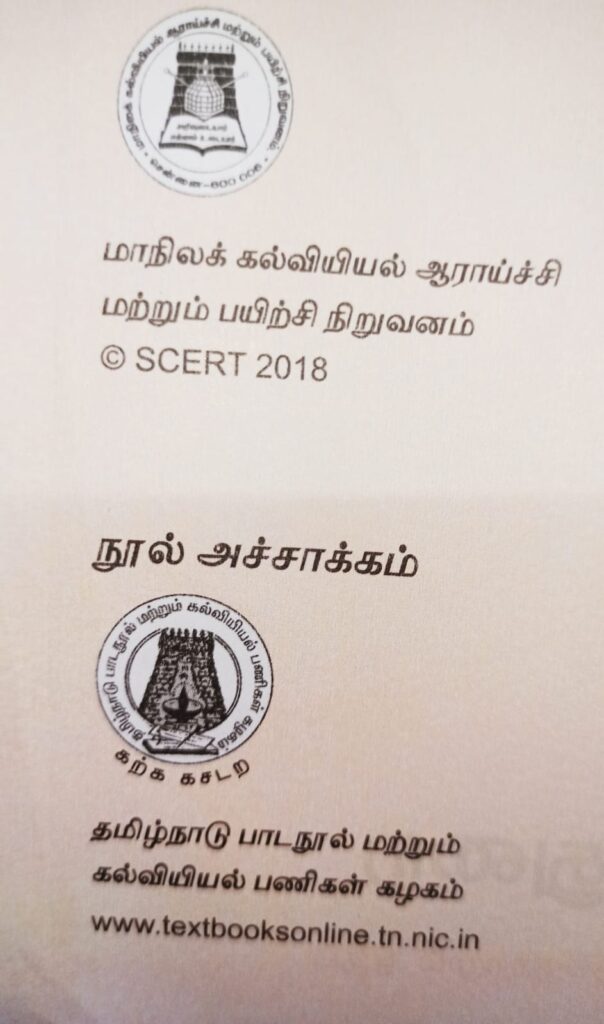
Lesson titled Ravana Kaviyam. Yes, you read it right. Still, if you have any doubt, the footnote at the end describes it distinctly that it is an antithesis of the original Ramayanam. It is a panegyric on Ravana, as the hero. In that book, all the nefarious characters in the original Valmiki Ramayana are portrayed as noble models while Rama and his companions are depicted as scurrilous specimens.
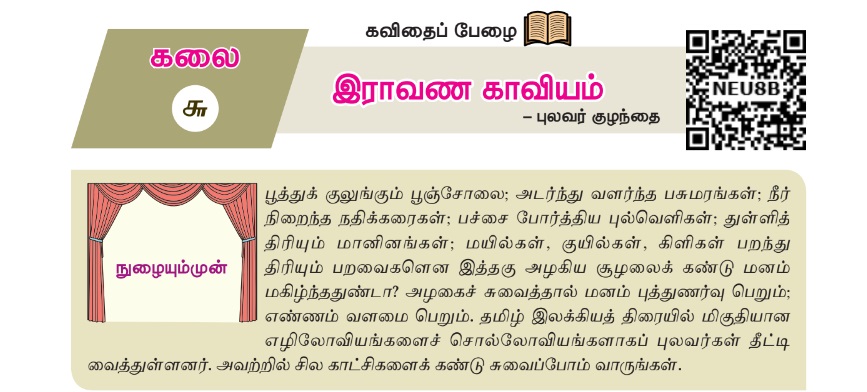
A small citation in the course of the lesson is by no less a person than the former Chief Minister C N Annadurai asserting that this work, Ravana Kaviyam is a necessity of the current age, a result of research, a spark of revolt, a glorious literature revealing the truth! The author is a follower of EVR, the Dravidian icon. This C N Annadurai had himself written a few controversial books on Kamba Ramayanam, viz., ‘Kamba Rasam’, ‘Thee Paravattum’. Their filthy contents, bordering on obscenity will be extremely revolting and repulsive to any ordinary reader.
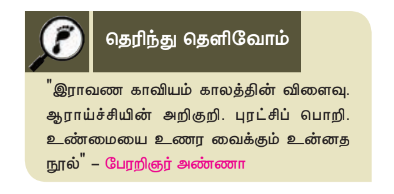
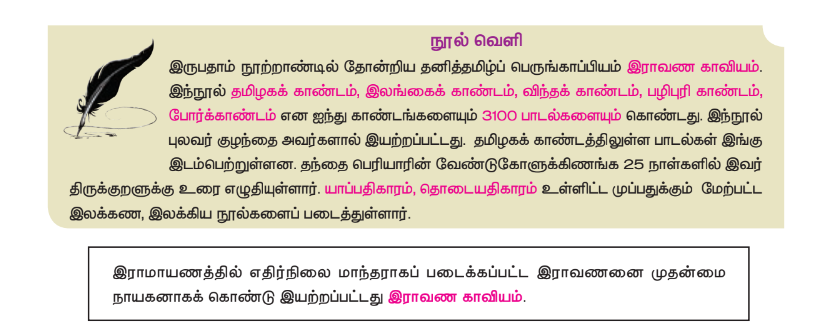
People have the freedom to write anything in a free society as long as it does not hurt others. If one chooses to even cross that Lakshman Rekha, others can either care to counter it with their own point of view or better still, just ignore it. For instance, a few years ago, a depraved director took a despicable film distorting the characters from Ramayana and it flopped at the box office since the audience did not relish it. But, can portions from a conspicuously controversial book be included in a school textbook? Worshipping Sri Rama is not only confined to Hindus or India. He is a venerated figure all over the world, transcending borders, religions, cults, etc. He is the human form of Dharma itself and this certificate is given not by any devotee of Sri Rama but by one from his enemy camp Mareecha:
रामो विग्रहवान् धर्मः साधुः सत्य पराक्रमः।
राजा सर्वस्य लोकस्य देवानाम् इव वासवः॥ [Aranya Kandam 37-13]
This beautiful shloka by Mareecha gives a one shloka definition for Sri Rama: “Rama is the embodiment of Dharma. He is a noble person. bestowing welfare to every creature. His valour never goes in vain. Just as Indra is the king of the Gods, Rama is the king of this entire universe.”
A lesson in a school textbook must be studied, and neither the teacher nor the students have the liberty to contradict its contents while doing so. One may individually hold a differing opinion in private, but expressing such diametrically opposite views in the classroom or writing them during examinations is not permissible. This practice plants pernicious postulates in the impressionable minds of the young. The inclusion of such material in textbooks, and its continuation for years, is beyond comprehension. Will anybody bell the cat?
Another lesson is ‘Periyarin Sindanaikal’. Almost all the statements not only adhere to ‘Purusha Thantram,’ as elucidated below, but they also abound with numerous incorrect and disputable falsehoods masquerading as facts.
In Tharka Sastram, the equivalent of Logic, there are two terms, ‘Vasthu Thantram’ and ‘Purusha Thantram’. The former refers to statements of universal truths independent of the person who expresses it while the latter is a statement of individual opinion. Consequently, the latter is subject to deliberations, debates, and corrections. When one goes through the book, one can see that a major part of the book contains the second variety also with a blatant leaning towards the Dravidian doctrine.
Persons like Dr. U V Swaminatha Iyer, Thiru Vi Ka, just to mention a few, who contributed significantly to Tamil literature are conspicuously absent while characters like Caldwell, Max Mueller, and William Jones, evangelists who studied our language with a hidden agenda, are excessively eulogised. None of the lessons contains promotion of a nationalistic spirit; patriotism is scrupulously confined only to the mandatory first page of the national anthem and integration pledge. Why can’t it include lessons on freedom fighters like Neelakanta Brahmachari, V O C, Satyamurthy or prominent public figures like Abdul Kalam, C V Raman, etc., or heroes in Indian history like Chhatrapati Shivaji, Krishna Deva Rayar, etc.?
Incidentally, we do not object to alternative views on anything, per se. In fact, our Sanathana Dharma, wrongly christened as Hinduism is the most equitable and egalitarian in its approach. It is never dogmatic or peremptory. It encourages deep inquiry by the student. Our Upanishads are mostly in the form of questions and answers between the teacher and the taught (student). In Srimad Bhagavad Gita, the most popular work where Arjuna prostrates before Lord Krishna pleading, ‘I am confused. I consider you as my Guru. Kindly guide me.’ Lord provides him with an elaborate set of teachings extending to all aspects of life. But, it is significant to note that at the end, in the eighteenth chapter, he says,
इति ते ज्ञानमाख्यातं गुह्याद्गुह्यतरं मया |
विमृश्यैतदशेषेण यथेच्छसि तथा कुरु ||18-63||
[“Thus, I have explained to you this knowledge that is more secret than all secrets. Ponder over it deeply, and then do as you wish. The Lord gives Arjuna the freedom to contemplate all his words and then decide for himself a further course of action. Can such a statement be found in any texts of any other religion?”]
Just to illustrate the scope for arguments in our Sanathana Dharma. let us take the history of Sankaracharya. By an impeccable knowledge of all our scriptures, intellectual acumen, and consummate logical skills, he was able to convince and win over as many as 72 other religious doctrines and establish the preeminence of his postulate, Advaitam.
Sanathana Dharma is all inclusive. As for the so-called atheism that the Dravidians proudly profess from the pulpit, it is already present in Sanathana Dharma. It is called, Charvakam. As such, we are not objecting to their doctrine. But, including it with ulterior motives while simultaneously excluding the basic tenets that are being followed by the majority of society scrupulously in school textbooks smacks of sinister motives. The mischievous intention is to poison the tender minds of the young and nurture them into a negative individual, a burden to society. Moral lessons, virtuous conduct, and faith in a higher power that guides one in the righteous path are the initial motivating factors that shape the personality of the youth. The pathetic fact is that other avenues of information have already been polluted beyond repair. The TV serials with plenty of hateful and hideous content contaminate the minds of the housewives. The less said the better on the present-day films. If the schools too fail to shape the character of the children at their formative age and thus turn them into irresponsible citizens, what will happen to the health of the society?
Not only the contents of this particular Tamil book, but the entire set of books, especially history should be thoroughly rewritten. The defeatist descriptive narration in detail under the Mughals and the British thrust on us by the anti-national scripters should be drastically reduced and instead, triumphant details of Lachit Borphukhan, Rana Pratap Singh, Bappa Rawal, Chhatrapati Shivaji, Rajaraja Cholan to mention a few should be included on an all India level, promoting the nationalistic spirit and an attitude to serve the society. Even after independence, for several decades the rectification task has been inexplicably delayed. Let us start now.
Those who freely include this in the book citing freedom of opinion, have the guts and gumption to attempt such opprobrious stuff from the literature of other religions? We do not, even for a moment suggest that step. Our question is ‘Why such freedom is exercised only in the case of the Hindu religion?
Parasuram Sharma is a retired bank officer and an octogenarian whose interests include Sanathana Dharmam, Samskritam, history and politics.
Subscribe to our channels on Telegram, WhatsApp, and Instagram and get the best stories of the day delivered to you personally.




